Cleaning BC Parks Beaches, the Marine Trails Way
Categories:
Guest Blog Post: BC Marine Trails Network Association
There are some really remote marine parks within the BC Parks system that are not visited regularly simply because they are hard to get to. These parks however, are often premium destination sites for paddlers who love to travel and explore the ever expanding BC Marine Trails Network.
Lawn Point and Brooks Peninsula Provincial Parks, both situated on the northern portion of the west coast of Vancouver Island, are two of these remote parks. Situated only 18 km apart in a straight line across Brooks Bay, they frame an exposed, rugged shoreline riddled with other amazing, isolated beaches scattered between them. So, to be true to sentiments of ‘duty of care’ for these special places held by BC Marine Trails supporters, these two parks became an obvious focus for the Association’s 2015/2016 cleanups of flotsam, jetsam, and whatever else…
A Tsunami cleanup program provided the vehicle: the effort was assisted by the Vancouver Aquarium and funded by the Japanese and Canadian governments.
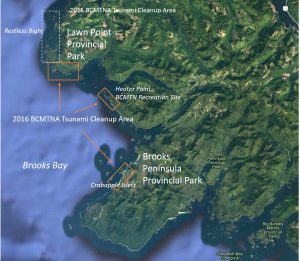
JULY, 2015: Twenty members of the BC Marine Trails Network Association drove north to Port McNeill, turned left to Port Alice, then hobbled along various logging roads in order reach a launch point at Gooding Cove, north of Restless Bight in Quatsino Sound. They then paddled south to the northern end of remote Lawn Point Provincial Park, and over one week gathered 3.8 tons of flotsam and jetsam from Kwakuitl Point within the park and the other beaches within the Restless Bight area.
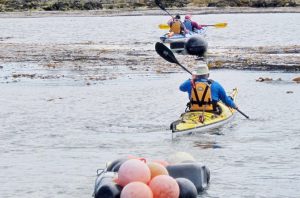
These beaches extend for almost 11 km, so kayaks often became debris transportation tools of choice, as it was easier to float and tow a lot of the debris to central collection piles rather than carry it along the beaches and over rocky headlands by hand.

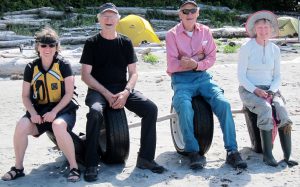
After a week of collecting and piling the debris, it was towed out to a small barge, loaded, taken to Coal Harbour, then weighed, (wow…3.77tons!) and trucked for final sorting and recycling to a landfill near Port Hardy.
JUNE, 2016: The following year, inspired by the success of 2015’s cleanup, twelve members of the BCMTNA decided to brave cloudy, rainy weather conditions and head back to finish some unfinished business in the Lawn Point, North Brooks area. Once again, the route was driving up to Port McNeill, and along a further 160 km of logging roads, to an accessible beach launch, this time at Side Bay, the only access point between Lawn Point and Brooks Peninsula Provincial Parks.
The two major focuses: 1) cleaning up the rest of the Lawn Point shoreline, and 2) the first stage of a cleanup on the northern portions of the Brooks Peninsula’s shoreline. Also on the list and located between the two were the beautiful beaches of Heater Point, a BCMTN Recreation Site.
Neither Lawn Point nor the Brooks Peninsula have any form of road access either within the parks or nearby. Few boats can land easily at either location, and then, there’s always the weather to consider…. ‘Definitely a job for inspired and intrepid kayakers!
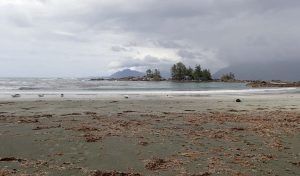
The group split into two, the first, off to Lawn Point, with the second group scurrying off to Crabapple Islets before the weather changed. Crabapple Islets are a 2.5 km set of beaches situated along the northern side of the Brooks Peninsula. One of the remotest spots on the west coast of Vancouver Island, these islets are the last reasonably sheltered beach landing before Cape Cook.
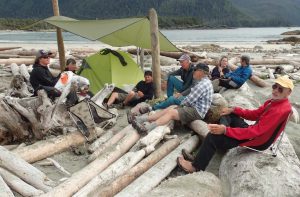
‘As the weather gods smiled upon us…, each volunteer loaded a net bag and a super sack or two upon their decks; shovels and tote liners were also loaded upon the most intrepid kayakers and all set off to our destination…’ stated the team leaders, Reale and Jeff.
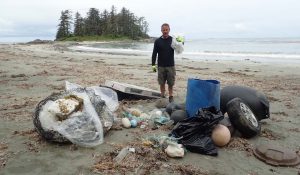
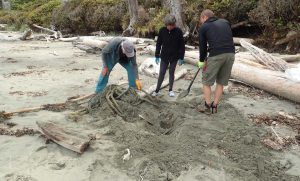

After a few days of busy collecting, sorting, piling and tying debris in locations away from high tide threats along the North Brooks beaches adjacent to Crabapple Islets, the team moved on to Heater Point Recreation site to do the same there.
Finally, after a full week of work, it was back to Side Bay for this crew, and a meet up with the Lawn Point crew for the evening to compare stories. Then it was off the next morning on the long journey home.
So what about pickup?? Are we leaving all that stuff there, out on those beaches?? Of course not…. Bring on the Vancouver Island Marine Debris Working Group (VIMDWG) and the Gar-Barge Project! VIMDWG is a group of non-profit organizations and clubs who coordinate together and share ideas about conducting large scale volunteer cleanups and disposal of tsunami and other debris off the west coast of Vancouver Island. The BCMTNA has been an active member of this group for 2 years.
Pick-up is always problematic for each individual cleanup, so this year a plan was developed to coordinate everyone’s efforts. So the Gar-Barge project was developed. Essentially, it means the teams secure the debris away from tidal hazards and in locations where a helicopter can access them safely. They are tied and prepped, and coordinates are taken of each location and passed on to the Gar-Barge planners.
Sometime in September, depending on weather, a barge will travel down the length of Vancouver Island’s west coast, collecting the debris as it is delivered by helicopters from each site. The barge will then deliver the debris to recycling facilities in the Lower Mainland.
Written By Stephanie Meinke




